June 10-13, 2024
Women Working with Clay Symposium is about women who work with clay to create pottery, art vessels, and sculpture, and whatever point of view may come with that distinction. The symposium explores the connections of the long history of women in cultures all over the world as vessel makers, artists, and artisans.
Founded in 2011, this symposium was created to honor the great accomplishments of women ceramic artists today. The objective of the symposium is to create an environment that is full of ideas, images, demonstrations, artwork, and discussions.
It is intended as a place for learning and inspiration. It is a place for everyone to share stories of struggles and successes. It is a place to see where we stand in the present, to better understand our past and to support each other in our future.
2024 Presenters: Aysha Peltz, Joanne Seongweon Lee, Christina A. West
Guest Speaker: Christa Assad
Director: Dara Hartman
Founding Director: Donna Polseno
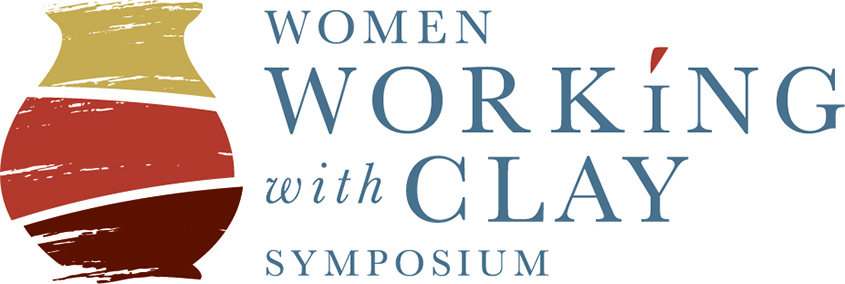
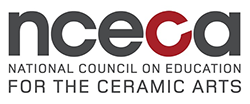
Questions?
Assistant Director of Special Programs Brittany Wade is happy to answer your questions.
Techniques Explored
Altering
Coil Building
Darting
Decals
Hand Building
Mishima
Mold Making
Sculpting the Figure
Sgraffito
Slip Casting
Slab Building
Stamping
Stencils
Surface Decoration
Texture
Throwing
Underglazes
Using molds
Using Templates
2024 Women Working with Clay Presenters
Aysha Peltz
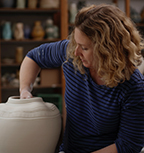
Peltz is a studio potter and a member of the visual arts faculty at Bennington College in Vermont. For over 20 years, Peltz and her husband, Todd Wahlstrom, have run Studio Pro Bats, producing throwing bats for potters. Peltz received her B.F.A. and M.F.A. from Alfred University and also did graduate studies at the University of Massachusetts, Dartmouth. For the last few years, Peltz, alongside Chris Gustin and Bruce Dehnert, has helped to curate the Old Church Pottery Show and Sale in Demarest, NJ.
Peltz has taught at several schools and art centers including: Arrowmont School of Arts and Crafts, Haystack Mountain School of Crafts, Alfred University, and the Kansas City Art Institute. In 2005, Peltz was awarded an Emerging Artist Award at the National Council for the Education of the Ceramic Arts. In 2019, she was a demonstrating artist for the NCECA conference in Minneapolis, MN. Peltz’s work is in many collections, including the American Museum of Ceramic Art, The Schein-Joseph International Museum of Ceramic Art, Jingdezhen Ceramic Institute, and the Huntington Museum of Art, where she received the Walter Gropius Master Award.
demonstration description:
I will demonstrate my making process using a potter’s wheel to throw porcelain and alter it while it is still wet and pliable. My pots are built on basic geometries: cylinders or cones varying in proportions with suggestions of volume. Working from this foundation, I will add layers of texture and dimensional lines, which I will then push, cut, rip, and fold to create the finished forms. During these demonstrations I will make some of my favorite pots: vases, platters, and lidded jars.
artist statement:
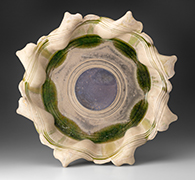
“I make pottery that explores imagined space, scale, and the poetic properties of the ceramic medium. I believe most good pots, whether functional or not, conjure associations beyond practical use. The forms I make reference utility and stir emotions; their familiarity creates an invitation to explore further.
My process is a series of considered alterations: a push into the inside or outside of a freshly thrown porcelain wall, expanding the texture from behind, creating curves and swells in the form. This way of working naturally creates suggestions of terrain, parched earth, a body in motion, or the imminent decay of something overripe. To further emphasize these qualities, I fire the work under fluid, translucent glazes, which preserves “moments” in the fired clay.
My pleasure in making these pieces is being lost in their surfaces and imagining myself in their landscape; a journey in which references become allusions. Ultimately, I’m most satisfied by the phenomenon that occurs when I push against a thrown and textured form to reveal something unique to the properties of clay.”
Joanne Seongweon Lee
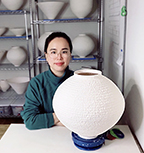
Originally from South Korea, Lee received her B.F.A. from New York State College of Ceramics at Alfred University with a concentration in ceramics in 2015. After graduation, she returned to South Korea for an artist-in-residence program at the Korea Ceramics Foundation: Icheon Cerapia. She completed an M.F.A. from Cranbrook Academy of Art in 2019 and achieved the Franz Rising Star Project Scholarship: Outstanding Performance in Porcelain Design in that same year. After graduating, she finished her residency at Sonoma Ceramics in Sonoma, CA. In 2021-2022, Lee taught at James Madison University in Harrisonburg, VA. Currently, she is at Anderson Ranch Arts Center as the ceramics coordinator in Snowmass Village, CO.
demonstration description:
I will demonstrate how to thinly coil and build an elegant moon jar step by step. During this symposium, I will start with the fundamentals of rolling coils and pinching to make basic shapes such as cylinders, bowls, and reversed bowl shapes. After practicing with basic forms, I will demonstrate the final goal of making a beautiful moon jar.
artist statement:
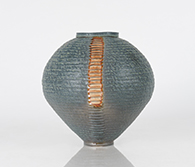
“My life has been filled with constant dislocation and relocation. I have many homes but not one that helps me feel wholeheartedly grounded and as though I belong both physically and emotionally. Through my practice and handcrafted objects, I create a mental and physical space in which my objects can comfortably stay present in the contemporary while paying tribute to my cultural heritage that I hold dear. Naturally, traditional Korean ceramics has become my most prominent interest and focus of research.
Historical Korean pottery is an elegant depiction of beauty while at the same time, it remains unpretentious and modest, which reflects the makers and their attitude toward their objects. I attempt to practice and embody such virtue in my studio by adapting materials, techniques, and methods through which I can connect with my cultural heritage and artistically embrace my longing for belonging. Throughout the past several years, I have immersed myself in wheel-throwing in porcelain and most recently with thin coil-built forms. My coiled forms are a physical conceptualization of Korean ceramics; especially that of moon jars (Dal Hangari, the traditional Korean ceramics originating from the Joseon Dynasty). While directly referencing the forms of various historical moon jars, my objects take on variations that emerge from the lines and curves I observe from many other historical artifacts present in traditional ceramics of Korea.
By taking a purist approach to color, form, and configuration, I allow the essence of clay to remain the emphasis of my work. Through my profound interaction with the materials, I have learned that the challenging qualities which come with working with clay, when overcome, eventually highlight both elegance and subtlety. As I remove myself from the wheel and transition to coil-building, I am able to explore new qualities of clay through rather unusual construction methods. Using especially thin coils in my process allows me to control many physical qualities such as weight, size, thickness, form, and time. The more control I can achieve, the more balanced and refined the objects become. The more time spent on each work, the more sincere and alive they become as my energy and focus migrate throughout. I intentionally preserve the seams formed between each coil, representing endurance and acceptance between the clay and myself as the maker. Each coil must shoulder the weight of subsequent coils that pile on top of one another. When these coil-constructed objects reach structural and aesthetic balance, I consider the forms complete. These objects serve as metaphorical vessels that contain my cultural background, personal memories, and the profound emotions accumulated along the coils and facades.”
Lydia Thompson
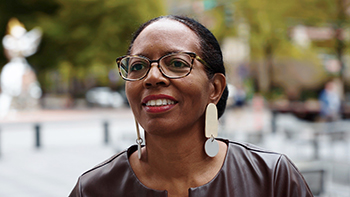
Lydia Thompson is a mixed media artist and received her Bachelor of Fine Arts degree from The Ohio State University and her Master of Fine Arts degree from the New York College of Ceramics at Alfred University. Her awards include a Fulbright Hays grant to conduct research on traditional architecture in Nigeria, a Windgate Distinguished Fellow for Innovation in Craft. She was an artist-in-resident at the Medalta Ceramic Center in Medicine Hat, Alberta, Canada; the Guldagergaard International Ceramic Research Center in Denmark; and at the Hambidge Center for the Creative Arts and Sciences. Her work has been included in galleries, art centers, and museums such as the Mindy Solomon Gallery, the Society for Contemporary Crafts, the Baltimore Clayworks, the Ohr O’Keefe Museum, the Kentucky Museum of Art and Craft, James A. Michener Art Museum, the Crocker Art Museum, the Mint Museum, and the Northern Clay Center. She has completed public commissions for businesses and her work is in private and public collections in the US, New Zealand, Austria, Switzerland, and Italy. She has conducted workshops for youths and adults, given public lectures,; and served as a juror and curator for national and regional exhibitions. Currently she resides and maintains her studio in Charlotte, NC, and is a professor of ceramics in the department of art and art history at UNC Charlotte.
demonstration description:
I will demonstrate my hand building (coiling and slab) techniques to build architectural organic structures. My process includes working on several pieces simultaneously at different stages to maximize time. I will discuss how my experiences, references, and inspirations become my inventory to develop this body of work.
Artist Statement:
My current research investigates the ideas of migration and residual ancestral memories that examine space and place that reference human existence. Through continuous mobility and the physical process of reduction made by nature, human beings create pathways that explore physical space that may produce visual silence, evoke the imagination, offer notions of commodities and value, and illustrate a sense of desperation that provides insights to various cultural practices and traditions. I also see my images as reminders of the past and current lessons that we need to learn about the persistence and preservation of one’s own culture.
Christina A. West
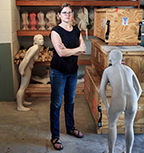
West is an artist whose practice is rooted in politics of the gaze, using sculpture, video, and photography to focus on the male body. West earned her M.F.A. from Alfred University (Alfred, NY) in 2006 and B.F.A. from Siena Heights University (Adrian, MI) in 2003. After living in Atlanta for 13 years where she taught at Georgia State University, West recently relocated back to the Midwest where she is now a professor at the University of Wisconsin-Madison. She has extensively exhibited her work across the country in venues such as the Mattress Factory (Pittsburgh), The Everson Museum of Art (Syracuse), Hallwalls Contemporary Arts Center (Buffalo), and Atlanta Contemporary. Her work has been supported by grants from the New York Foundation for the Arts, the Virginia Groot Foundation, and the Puffin Foundation, and she has participated in residencies at The Bemis Center for Contemporary Art, The Archie Bray Foundation for the Ceramic Arts, The Vermont Studio Center, and The Clay Studio of Philadelphia.
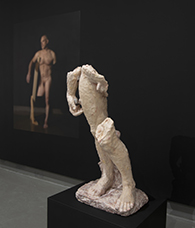
demonstration description:
I will demonstrate the working methods I use to hollow build my realistically rendered figurative sculptures. I will discuss the ways I determine proportions, get figures to stand, and sculpt details such as facial features, hair, and hands.
artist statement:
“The inherent mystery of others’ interiority, and the tension between a desire to connect and a discomfort in social situations, make the human figure an endlessly captivating subject for my sculpture and videos. My work is rooted in figuration as a way to try to understand and connect with others and is informed by contemporary art criticism and social theory about the gaze as a way to call out dynamics and politics that complicate the act of looking. Broadly speaking, addressing the gaze allows me to reflect on my relationships to others and consider what those dynamics can reveal about how we understand ourselves and others.
A few years ago, I made the decision to exclusively work with the male body in my studio practice. I became exhausted by the inward, self-reflexive gaze that the “male” (patriarchal) gaze ingrained in me as a cisgender woman and began focusing on my outward gaze at that which I desire and am curious about. Though I use binary gender terms at times, the overarching goal of my work is to represent a gender dynamic that is less polarizing or limiting for any person and comes from a place of empathy. My hope is that this work begins untangling culturally imposed limitations on gender— whether that be limitations felt by female creators such as myself or limitations imposed on the way bodies of various genders have been represented. I am searching for representations that convey the complexity of my subjects, blending a combination of beauty, strength, and confidence with vulnerability, awkwardness, and insecurity to counter centuries of depictions of bodies as caricatured representations.”
Christa Assad
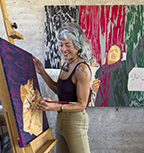
Guest speaker – opening lecture: Be the Sculptor, Be the Maker of your Life’s Greatest Dreams
I will connect the five predominant themes in my life – education, travel, resourcefulness, risk-taking, and resilience – as they pertain to my career path and its many reinventions.
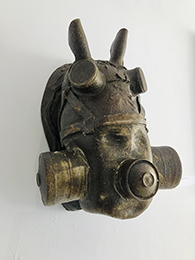
Assad is a feminist artist based in Baja, Mexico. Her recent exhibitions focus on women heroes of Mexico and Afghanistan, and the plight of women of these countries and many other patriarchal nations. Assad was awarded a J. William Fulbright Research and Travel Grant (1993) and was nominated for the Louis Comfort Tiffany Biennial Award (2005). Her work is in the Fine Arts Museums of San Francisco; the Cafesjian Center for the Arts in Yerevan, Armenia; the Ceramic Research Center at Arizona State University Museum; and the Penn State Fulbright Collection.
Artist Statement:
I have called myself a clay artist for more than 30 years now, but for the last decade my creative process has moved between potting and painting. While I see them as branches off of the same tree, and rooted in one thematic concept, the two mediums have yet to converge. More accurately, one is a respite from the other. Some days I just don’t feel like getting dirty, and I want color to be immediate and gratifying, rather than elusive and unpredictable (such as it is with my wood kiln). On other occasions, I crave that incomparable grounded, centered feeling of sitting at the potter’s wheel, hands in the wet clay.
Whichever medium I choose, the important thing is engaging the hands so that my mind may disconnect. I research and write, but the making is my meditation: a time to shut off the brain and activate the intuitive self. The older I get, the more I realize the importance of this – the gift, the privilege of being an artist – and the responsibility I have to myself and to humanity to use this gift wisely.
Currently, my work is focused on women in oppressed cultures, and the effects of patriarchal society and conditioning. Whether I turn the lens on Afghanistan, Mexico, or the United States, there are almost always instances of repressed women to be found. Using visual art as my language, I find it easier to broach this subject matter with the public. Color, in particular, can create a more palatable entryway, and can evoke emotion in a rather subliminal way. My sculptural work, such as the grenades, is used to provoke conversation about the fetishization of war objects and weapons. It is my hope that anyone can look at my work and feel personally connected to these issues in some way. By removing myself, my ego, from the experience and allowing the art to do the real work, it is possible that change can happen.
Meet the Directors
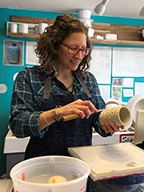
Dara Hartman is a full-time studio artist based in Salt Lake City, UT. She received a B.F.A. from Virginia Tech and an M.F.A. from Montana State University. In 2005, she was an artist-in-residence at the Archie Bray Foundation in Helena, MT. After graduate school she moved to Washington and was an adjunct professor at Clark College in Vancouver, WA, and at Oregon College of Art and Craft in Portland, OR. While in Oregon she was commissioned by Marriott to create 70 figurative sculptures for their Courtyard by Marriott Portland City Center hotel. Most recently, Dara’s life has taken her to Salt Lake City, where she worked for three years as a product designer and as a design team leader, and traveled to China to work with factories on model design and production. Dara was a presenter at the inaugural symposium in 2011, became the assistant director in 2018, and is now director of the symposium.
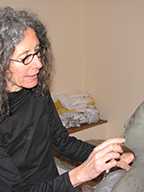
Donna Polseno developed and founded the Women Working with Clay symposium in 2011. She received a B.F.A. from the Kansas City Art Institute and her M.A.T. from the Rhode Island School of Design. She moved to the mountains of Virginia after graduation and has been a studio artist since 1974. She started her career making pottery which she continues to do, but diverged to a parallel career of making figurative sculpture in the 80’s. She has received two National Endowment of the Arts Grants and a Virginia Museum Fellowship. Essays about her work have been published in many magazines including Art & Perception and Ceramics Monthly. She is in several books about pottery and sculpture including Sculptural Ceramics (cover photo) by Ian Gregory. She has taught many workshops and summer programs at schools including Penland School of Crafts, Arrowmont School of Crafts, The Bascom, Appalachian Center for Donna Polseno workCrafts, Long Beach Foundation, and Anderson Ranch Art Center. She has been an invited participant at a symposium in Izmir, Turkey, has taught twice at the WVU exchange program in Jingdezhen, China, and teaches each summer at La Meridiana- International School for Ceramics, in Italy, as well as showing in the second annual “Concreta” exhibiton in Certaldo. She taught ceramics at Hollins University since the inception of the ceramics program in 2004, through her retirement in 2020.
Sponsors
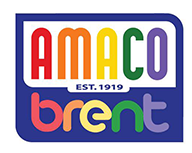

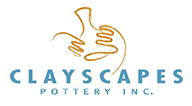
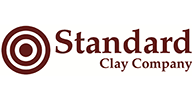
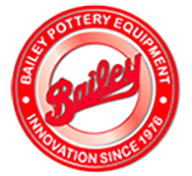



Past Presenters & Speakers
Jen Allen, presenter 2019, 2021
Adrian Arleo, presenter 2013, 2021
Mary Barringer, endnote 2011; presenter, 2012, 2021
Margaret Bohls, presenter 2021, 2022
Meredith Brickell, presenter 2014
Cynthia Bringle, endnote 2019
Gerald Brown, presenter 2021
Akiko Bush, keynote 2012
Danielle Carelock, presenter 2021
Syd Carpenter, presenter 2016, 2021
Janet Carty, speaker 2012
Linda Christianson, presenter 2015, 2021
Lisa Clague, presenter 2012
Sunshine Cobb, presenter 2018
Cristina Cordova, presenter 2015
Louise Cort, keynote 2016
Jenine Culligan, presenter 2021
Charity David-Woodard, presenter 2013
Chotsani Elaine Dean, presenter 2021, 2022
Louise Deroualle, presenter 2021; presenter 2023
Lale Dilbaş, keynote and endnote, 2017; presenter 2021
Sanam Emami, presenter 2023
Ruth Epstein, keynote 2011
Michelle Erickson, presenter 2016
April Felipe, presenter 2021
Raheleh T. Filsoofi, keynote and endnote 2014; presenter 2021; guest speaker 2023
Julia Galloway, presenter 2017
Andrea Gill, presenter 2011, 2021
Silvie Granatelli, presenter 2011, 2021; endnote 2016
Gerit Grimm, presenter 2017, 2021
Ursula Hargens, presenter 2023
Dara Hartman, presenter 2011, 2021; endnote 2018
Giselle Hicks, presenter 2014
Jeanine Hill, presenter 2021
Alice Honenberg Federico, endnote 2012
Ayumi Horie, presenter 2017
Rebecca Hutchinson, presenter 2018
Mary Dana Hinton, Ph.D., keynote 2022
Eva Kwong, presenter 2018, 2021
Suze Lindsey, presenter 2014
Beth Lo, presenter 2019, 2021
Liz Lurie, presenter 2019, 2021
Lorna Meaden, presenter 2021, 2022
Charlotte Middleton, presenter 2021
Amy Moorefield, speaker 2012
Ayla Mullen, presenter 2021
Sana Musasama, keynote 2023
Kathleen Nolan, keynote 2011
Winnie Owens-Hart, keynote 2018; presenter 2021
Leila Philip, keynote and endnote, 2015
Donna Polseno, presenter 2011, 2012, 2015
Liz Quackenbush, presenter 2016
Kari Radasch, presenter 2011
Deborah Schwartzkopf, presenter 2018
Ellen Shankin, presenter 2012
Linda Sikora, presenter 2014
Sandy Simon, presenter 2013
Stacy Snyder, presenter 2013
Linda Sormin, presenter 2022
Kala Stein, presenter 2011
Shoko Teruyama, presenter 2015
Cheryl Ann Thomas, presenter 2013
Lydia C. Thompson, keynote 2019
Tip Toland, presenter 2012, 2019
Moira Vincentelli, keynote 2013
Jeri Virden, presenter 2011
Patti Warashina, presenter 2017
Amethyst Warrington, speaker 2015
Adero Willard, presenter 2023
Linda Williams, speaker 2015
Gwendolyn Yoppolo, presenter 2014

